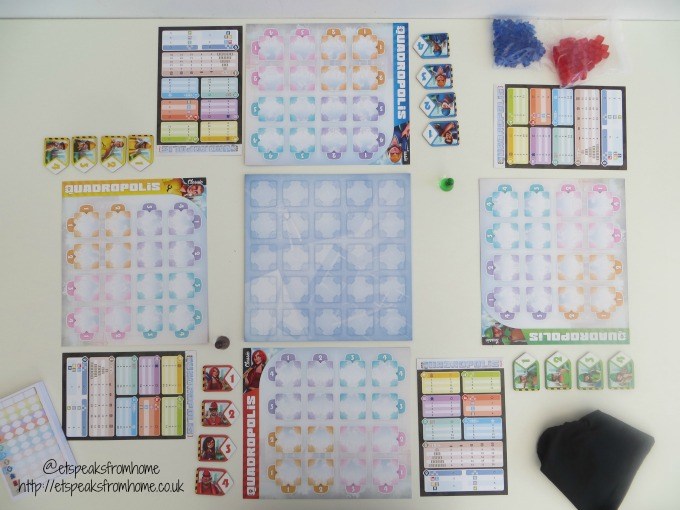Quadropolis is a strategy board game that sees players compete with one another for the shops, parks, public services and other structures to be placed in them. It is made by Days of Wonder. This game is suitable for ages eight and above and can be played by 2 to 4 players. It is available to buy from Esdevium store finder or on Amazon.

In Quadropolis, you enact the role of the Mayor of a modern city. You will need to define a strategy to build your city by sending your Architects to have various Buildings erected in your city. Each Building allows you to score victory points.
Inside the box, it comes with a Construction Site board, 4 double-sided Player Mats (Classic & Expert modes), 142 Building Tiles, 20 Architects, 1 Urbanist, 1 Mayor, 65 Inhabitants, 50 Energy Units, Scoring Pad, 4 Helpers, Cloth Bag and Instructions.

The building tiles are well made with thick cardboard and don’t have any sharp corners. The design on the tiles are simple and well printed. The pieces are made from good plastic materials. The box has plastic dividers to hold the items neatly.
There are two game modes: Classic and Expert. If this is your first time playing, it is best to start with Classic mode. It is simpler to understand and play. Before playing this game, it will require you to read through the instructions carefully. Mr C took about half an hour to setup and fully understand the game before he could teach us. It was quite complicated but once we got going, it was logical and very enjoyable.
The game lasts four rounds, and in each round players first lay out tiles for the appropriate round at random on a 5×5 grid. Each player has four architects numbered 1-4 and on a turn, a player places an architect next to a row or column in the grid, claims the tile that’s as far in as the number of the architect placed, places that tile in the appropriately numbered row or column on the player’s 4×4 city board, then claims any resources associated with the tile (inhabitants or energy).

When a player takes a tile, the urbanist is placed in this now-empty space and the next player cannot place an architect in the same row or column where this tile was located. In addition, you can’t place one architect on top of another, so each placement cuts off play options for you and everyone else later in the round. After all players have placed all four architects, the round ends, all remaining tiles are removed, and the tiles for the next round laid out.
Watch this trailer to learn how it plays: https://youtu.be/HwKLP7_qT78
After four rounds, the game ends. Players can move the inhabitants and energy among their tiles at any point during the game to see how to maximize their score. When the game ends, they then score for each of the six types of buildings depending on how well they built their city — as long as they have activated the buildings with inhabitants or energy as required:
- Residential buildings score depending on their height
- Shops score depending on how many customers they have
- Public services score depending on the number of districts in your city that have them
- Parks score depending on the number of residential buildings next to them
- Harbours score based on the longest row or column of activated harbours in the city
- Factories score based on the number of adjacent shops and harbours
Some buildings are worth victory points (VPs) on their own, and once players sum these values with what they’ve scored for each type of building in their city, whoever has the highest score wins.
It’s a lot of fun once you’ve played the game a couple of times to learn the strategy. I would recommend it! It’s a great concept and great quality game. We have not played the Expert mode yet as we are still getting into the game but I believe in no time, we will!
Disclosure: We received the sample for the purposes of writing this review however all thoughts and opinions remain our own. We have included an Amazon affiliate link to the product. If you click on this and buy, we may earn a small commission but at no additional cost to you.